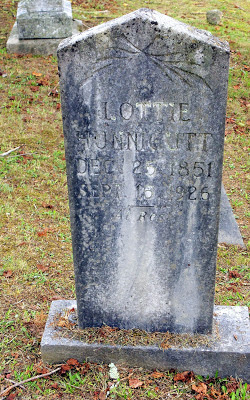So sayeth Rabun County, Georgia Ordinary James F. Smith back in 1913. But Lottie (maiden name Rogers according to online family trees) did marry Nathan Andrew Hunnicutt. She swore to that fact when filing for a widow's pension only several days after the death of said husband. She got a few other folks to sign sworn statements to that end, as well. (Application available for viewing at Ancestry.com.)
Under the heading of Questions for Applicant, Lottie stated she and N. A. Hunnicutt were married 3 December 1865 in Rabun County, Georgia. About 3 weeks before Lottie's 14th birthday. Lottie also claimed to have only $225 worth of worldly goods and property, including two small town lots and a house on Park Street in Mountain City making up the majority with a value of $200.
More information about N. A. Hunnicutt's service to the Confederate cause was actually provided by a witness, I guess since Lottie and Andrew weren't married until after the surrender in 1865. N. A. Hunnicutt was a member of Company F, 11th Georgia Cavalry.
After the war, Lottie and Andrew settled down in Rabun County, Georgia and had many children. Census records suggest the number was 11. Andrew died 25 July 1913 and Lottie followed 15 September 1926. They both rest in the graveyard of Blue Heights Baptist Church in Mountain City, Georgia.
Photos © 2011 - 2013 S. Lincecum.
Note: Rabun County, Georgia is where the famous Foxfire books were created.
Under the heading of Questions for Applicant, Lottie stated she and N. A. Hunnicutt were married 3 December 1865 in Rabun County, Georgia. About 3 weeks before Lottie's 14th birthday. Lottie also claimed to have only $225 worth of worldly goods and property, including two small town lots and a house on Park Street in Mountain City making up the majority with a value of $200.
More information about N. A. Hunnicutt's service to the Confederate cause was actually provided by a witness, I guess since Lottie and Andrew weren't married until after the surrender in 1865. N. A. Hunnicutt was a member of Company F, 11th Georgia Cavalry.
After the war, Lottie and Andrew settled down in Rabun County, Georgia and had many children. Census records suggest the number was 11. Andrew died 25 July 1913 and Lottie followed 15 September 1926. They both rest in the graveyard of Blue Heights Baptist Church in Mountain City, Georgia.
 |
| Lottie Hunnicutt Dec 25, 1851 Sept 15, 1926 At Rest |
 |
| Andrew Hunnicutt b. June 4, 1845 d. July 25, 1913 Beloved father, farewell. |
Note: Rabun County, Georgia is where the famous Foxfire books were created.

Comments